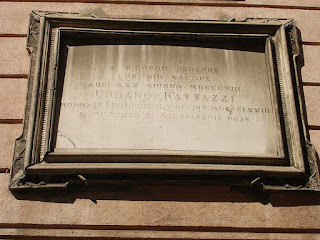Alberto Magnelli - abstract painter
Self-taught artist whose work became known as Concrete Art
The abstract painter Alberto Magnelli, who became a leading figure in the Concrete Art movement, was born on this day in 1888 in Florence. Concrete Art is described as abstract art that is entirely free of any basis in observed reality and that has no symbolic meaning. It had strong geometric elements and clear lines and its exponents insisted the form should eschew impressionism and that a painting should have no other meaning than itself. The movement took its name from the definition of concrete as an adjective rather than a noun, meaning ‘existing in a material or physical form’. It became Magnelli’s focus after he moved to Paris in 1931. Until then, he had experimented in various genres. He was born into a comfortable background in Florence, his father coming from a wealthy family of textile merchants. Read more…
___________________________________
Gino Meneghetti - career burglar
Pisa-born criminal became legend in Brazil
Gino Amleto Meneghetti, a small-time thief in Italy who became a romanticised figure for his criminal exploits after emigrating to Brazil, was born on this day in 1878 in Pisa. His early days were spent in a fishing village outside Pisa, but his father could find only low-paid work and moved the family to a different neighbourhood so he could take a job in a ceramics factory. It was there that Gino fell in with a gang of boys who regularly engaged in petty crime, stealing fruit or chickens or other objects of minimal worth. The young Meneghetti was arrested for the first time at 11 years of age. After teenage years spent largely thieving, he made an attempt to change his life, going back to the classroom to learn to be a mechanic and a locksmith. He found work and saved money, but then decided to move to Marseilles in France to live with an uncle, who owned a restaurant. Read more…
_____________________________________
Clara Gonzaga – noblewoman
Countess from Mantua founded European dynasties
Clara (Chiara) Gonzaga, the eldest daughter of Federico I Gonzaga and Margaret of Bavaria, was born on this day in 1464 in Mantua. One of her six children became Charles III, Duke of Bourbon and led the imperial army sent by Emperor Charles V against Pope Clement VII in what was to become the Sack of Rome in 1527. Clara was also to feature as one of the characters in The Heptameron, a collection of 72 short stories written in French by the sister of King Francis I of France, Marguerite of Angouleme, who had been inspired by Giovanni Boccaccio’s The Decameron. Clara had five siblings, including Francesco II Gonzaga, who married Isabella d’Este. She was married at the age of 17 to Gilbert of Bourbon Montpensier. Four years later he succeeded his father as Count of Montpensier and Dauphin of Auvergne. Read more…
Achille Varzi - racing driver
Death on track led to mandatory wearing of crash helmets
Italian motor racing fans were in mourning on this day in 1948 when it was announced that Achille Varzi, whose rivalry with fellow driver Tazio Nuvolari made frequent headlines during the 1930s, had been killed in an accident while practising for the Swiss Grand Prix. Although the sun was shining, an earlier downpour had left parts of the Bremgarten circuit outside Berne very wet and Varzi’s Alfa Romeo 158 was travelling at 110mph (170kph) when he arrived at a corner that was both wet and oily. The car spun several times and appeared to be coming to a stop but then flipped over. The helmetless Varzi was crushed beneath the car and died from his injuries at the age of 43. His death was especially shocking because he was regarded as one of the more cautious drivers. Since beginning his career on two wheels in his teens he had suffered only one major accident. Read more…
____________________________________
Claudio Saracini – musician
Baroque songs have survived till modern times
Composer Claudio Saracini was born on this day in 1586 in or close to Siena in Tuscany. He is one of the most highly regarded composers of his time and is known also to have played the lute and been a singer. He became famous for composing monody, which is secular music for a single voice, and 133 of the songs he wrote in this style have survived till today. Some of Saracini’s compositions are still recorded, often in collections along with works by other composers of the same era, such as Monteverdi, who is said to have admired him. Saracini travelled widely and seems to have established useful connections abroad as he dedicated a lot of his music to foreign aristocrats. He also appeared to have absorbed some of the musical styles of the lands he visited in his own compositions. A unique feature of his work is the influence of folk music. Read more…
_____________________________________
Book of the Day: Atlas of World Art, by John Onians
The Atlas of World Art maps the cumulative traces of humankind's artistic activity and demonstrates the importance of physical and political geography for the history of the world's art. This stunning volume is the first to treat the art of the whole world from prehistory to present day and to show the importance of natural and social factors in shaping artistic activity. The Atlas is divided into seven parts, each devoted to a specific time period: Art of the Hunter Gatherer (50,000-5,000 BCE); Art, Agriculture and Urbanization (5,000-500 BCE); Art, War and Empire (500 BCE-600 CE); Art, Religion and Empire (600-1500); Art, Exploitation and Display (1500-1800); Art, Industry and Science (1800-1900); Art, Competition and Identity (1900-2000). Each section opens with a helpful timeline for that period bringing together important dates from across various cultures.John Onians is Professor of Visual Arts, School of World Art Studies and Museology, University of East Anglia, Norwich.



.jpeg)




.jpg)






_-_Exterior.jpg)

.jpg)
%20(2).jpg)


